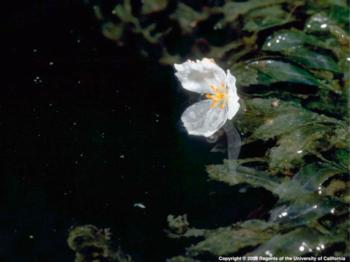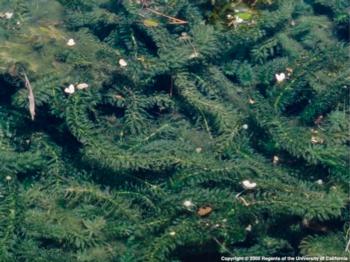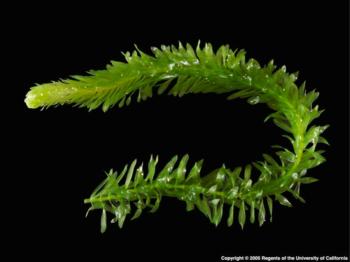Brazilian Egeria
| Common name | Brazilian egeria |
| Scientific name | Egeria densa |
| Family | Hydrocharitaceae |
| Range | Most western states including Washington, Oregon, Idaho, Colorado, Utah, Arizona, New Mexico, and California. Most common in Washington, Oregon and California. |
| Habitat | Slow-flowing or still water in ditches, sloughs, canals, rivers, ponds, lakes, reservoirs; often in nutrient-rich substrates. Plants are highly susceptible to iron deficiency and grow best under low light. Does not survive prolonged periods of near freezing temperatures. |
| Origin | Native to eastern South America. Brazilian egeria is still commonly sold as aquarium décor under the name Egeria or Anacharis. Plants can naturalize in warm temperate to cool sub-tropical regions when unwanted aquarium contents are released into lakes, ponds, or waterways. |
| Impacts | Brazilian egeria can aggressively invade new aquatic environments, displace native aquatic vegetation by forming dense stands or large sub-surface mats, and alter the dynamics of aquatic ecosystems. Other detrimental and economic impacts from heavy infestations can include water flow impediment in waterways, increased flooding, clogged pumps and boat propellers, and reduced use of lakes and waterways for fishing and other recreational activities. |
| Listed as a noxious weed in these western states | Oregon, Washington |
| California Invasive Plant Council (Cal-IPC) inventory | High invasiveness |
| Description | Brazilian egeria is a submerged perennial aquatic weed. Its stems typically grow rooted in the substrate. The leaves are sessile, 1 to 2.5 inches long in whorls of 3-6. On lower stems, the leaves are scale-like and opposite. The leaf margins are minutely toothed, visible with low magnification. Brazilian egeria is a dioecious species, but populations in the United States consist only of male plants. Male flowers extend 1.5 inches above the water surface on long thread-like flower tubes several inches long. The three petals are showy, glossy white and wrinkled. Because only male flowers occur in the western United States, there is no fruit production. As such, all populations of Brazilian egeria reproduce vegetatively, by stolons and stem fragments. Unlike hydrilla, Brazilian egeria does not produce tubers or turions. Plants can easily fragment into free-floating pieces that root at nodes, and these fragments can start new colonies when carried elsewhere. However, adventitious roots and lateral branches only grow from double nodes (specialized nodes separated by a shortened internode), typically spaced along stems at 6- to 12-node intervals. Only fragments with a double node develop into new plants. Vegetative parts disperse with flooding, waterfowl, and human activities, such as fishing and boating. |
| Non-chemical control | Mechanical (pulling, cutting, dredging) Removing and destroying stem fragments from recreational equipment, such as boat propellers, docking lines, and fishing gear can help prevent the spread of Brazilian egeria. Removing dense canopies by mechanical harvesting may stimulate growth and spread viable fragments. Diver-assisted dredging is very effective in small areas (< 2 acres). Cultural Dewatering (drawdown) during summer months may desiccate and kill sparse populations, but large biomass tends to form large clumps that protect the interior from drying out. Brazilian egeria grows Biological The triploid (sterile) grass carp (white amur) is a relatively nonselective herbivorous fish that will consume Brazilian egeria, and uses it as one of its most preferred diets. Some research is underway to determine the utility of a fly (Hydrellia sp.) whose larvae feed on Brazilian egeria, but no releases have yet been permitted in the United States. |
| Chemical control | The following specific use information is based on published papers and reports by researchers and land managers. Other trade names may be available, and other compounds also are labeled for this weed. Directions for use may vary between brands; see label before use. Herbicides are listed by mode of action and then alphabetically. The order of herbicide listing is not reflective of the order of efficacy or preference. Branched-chain amino acid inhibitor =Penoxsulam (Galleon)
|

Brazilian egeria male flower close up (J. DiTomaso. © 2005 UC Regents)

Brazilian egeria infestation in bloom (J. DiTomaso. © 2005 UC Regents)

Brazilian egeria plant close up (Jack Kelly. © 2005 UC Regents)
|


